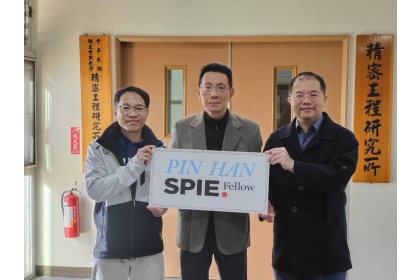Professor Pin Han of Graduate Institute of Precision Engineering, NCHU Was Appointed as a SPIE Fellow
2023-02-24
興新聞張貼者
Unit秘書室
1,603
The International Society for Optics and Photonics (SPIE), an authoritative organization in the field of electro-optical engineering in the world, recently announced the list of 83 new fellows. Professor Pin Han from the Graduate Institute of Precision Engineering of National Chung Hsing University (NCHU) was elected for his outstanding contributions in the fields of diffractive optics and optical design, which will help enhance Taiwan's international visibility in the field of optics.
Founded in 1955, the International Society for Optics and Photonics (SPIE) is a non-profit international organization dedicated to the research, engineering and application of optics, photonics and electronics. The number of members is as high as 264,000. At present, there are only more than 1,700 fellows, accounting for 0.5% of the number of members. The venue of the society is located in State of Washington, USA. It is also the most authoritative professional organization in the field of electro-optical engineering in the world. More than 350 international technical seminars are held every year. The conference papers published reflect the latest developments and trends, which are of high academic value. To be elected as a fellow, significant scientific research achievements must be made in multidisciplinary fields such as optics, photonics, and imaging technology.
Professor Pin Han specializes in optical engineering, near-eye display, and field integration. He is the director of the Advanced Optical Design Center of National Chung Hsing University. In 2021, he and his entire team won "Future Technology Award" of National Science and Technology Council for "Research on Prospective Lidar Camera Modules in Smart Electronic Fence System". He also won the Excellence Award for the briefing of the "Industry-University Cooperation Program Achievement Presentation and Performance Evaluation Meeting" from National Science and Technology Council for three times. A total of more than 100 SCI papers have been published and more than 40 patents have been obtained.
Having long been committed to the promotion of wide-spectrum optical diffraction theory and the application of optical design simulation, Professor Pin Han proposed an important and original space/wave number correspondence principle. In recent years, he has made important achievements in popular fields such as near-eye display and augmented reality. For example, the design of the world's smallest red, blue and green three-laser beam combining optical engine makes XR glasses lighter, thinner, shorter and smaller, and easier to implement. He is also one of the few teachers who demonstrate outstanding performance in both academic research and industrial application.
As Pin Han said, to be honored as a SPIE fellow, in addition to his own hard work for a long term, there is also the graduate students’ effort to study, the full assistance from the cooperative manufacturers, the strong support of National Science and Technology Council and National Chung Hsing University as well as the considerate dedication of his family. It is indeed the result of everyone's joint efforts. Therefore, after receiving this honor, Professor Han inspires himself to continue to make contributions in scientific research or industry-academia aspects by upholding the inertia of his continuous efforts in the past.
Founded in 1955, the International Society for Optics and Photonics (SPIE) is a non-profit international organization dedicated to the research, engineering and application of optics, photonics and electronics. The number of members is as high as 264,000. At present, there are only more than 1,700 fellows, accounting for 0.5% of the number of members. The venue of the society is located in State of Washington, USA. It is also the most authoritative professional organization in the field of electro-optical engineering in the world. More than 350 international technical seminars are held every year. The conference papers published reflect the latest developments and trends, which are of high academic value. To be elected as a fellow, significant scientific research achievements must be made in multidisciplinary fields such as optics, photonics, and imaging technology.
Professor Pin Han specializes in optical engineering, near-eye display, and field integration. He is the director of the Advanced Optical Design Center of National Chung Hsing University. In 2021, he and his entire team won "Future Technology Award" of National Science and Technology Council for "Research on Prospective Lidar Camera Modules in Smart Electronic Fence System". He also won the Excellence Award for the briefing of the "Industry-University Cooperation Program Achievement Presentation and Performance Evaluation Meeting" from National Science and Technology Council for three times. A total of more than 100 SCI papers have been published and more than 40 patents have been obtained.
Having long been committed to the promotion of wide-spectrum optical diffraction theory and the application of optical design simulation, Professor Pin Han proposed an important and original space/wave number correspondence principle. In recent years, he has made important achievements in popular fields such as near-eye display and augmented reality. For example, the design of the world's smallest red, blue and green three-laser beam combining optical engine makes XR glasses lighter, thinner, shorter and smaller, and easier to implement. He is also one of the few teachers who demonstrate outstanding performance in both academic research and industrial application.
As Pin Han said, to be honored as a SPIE fellow, in addition to his own hard work for a long term, there is also the graduate students’ effort to study, the full assistance from the cooperative manufacturers, the strong support of National Science and Technology Council and National Chung Hsing University as well as the considerate dedication of his family. It is indeed the result of everyone's joint efforts. Therefore, after receiving this honor, Professor Han inspires himself to continue to make contributions in scientific research or industry-academia aspects by upholding the inertia of his continuous efforts in the past.


